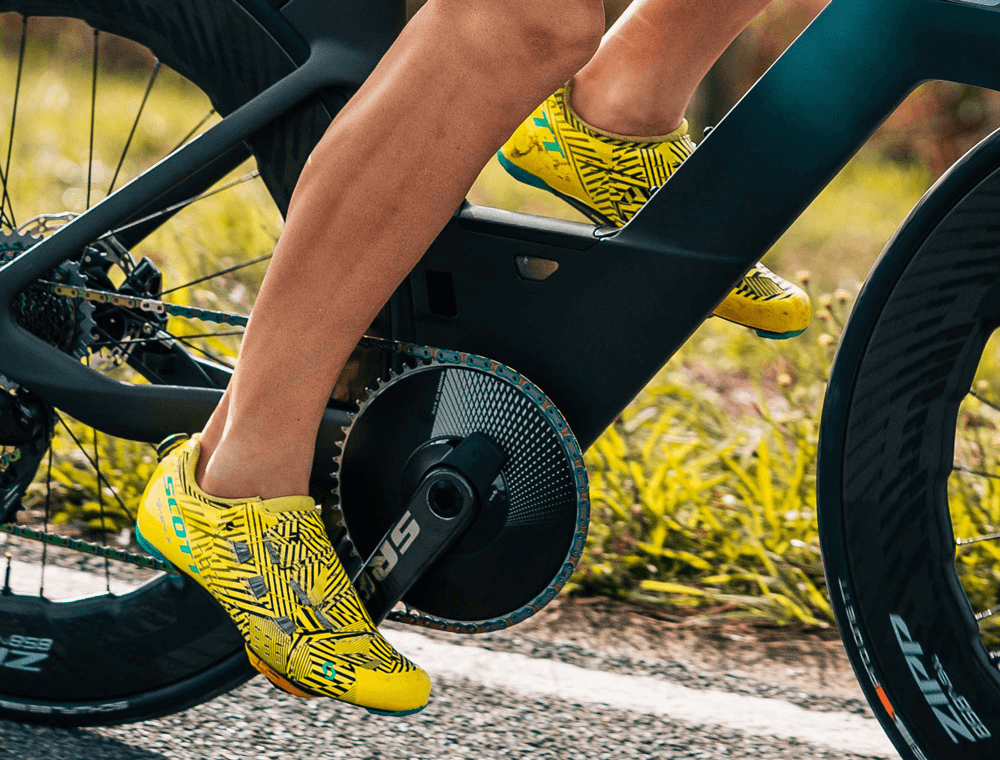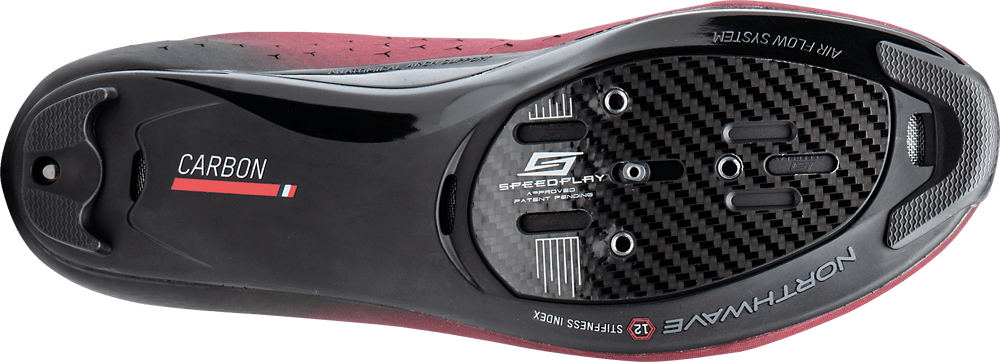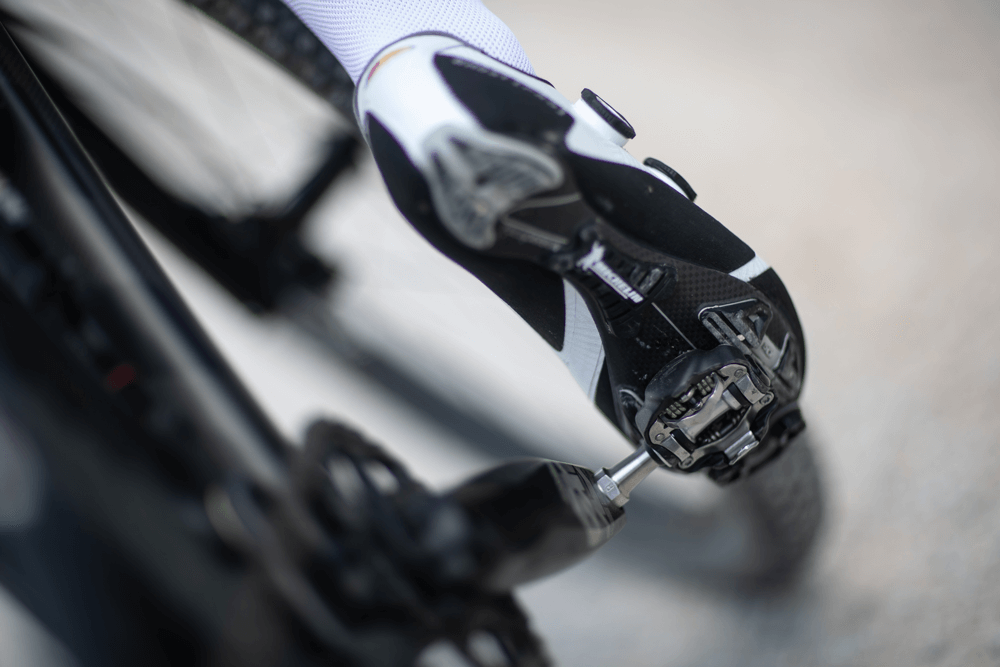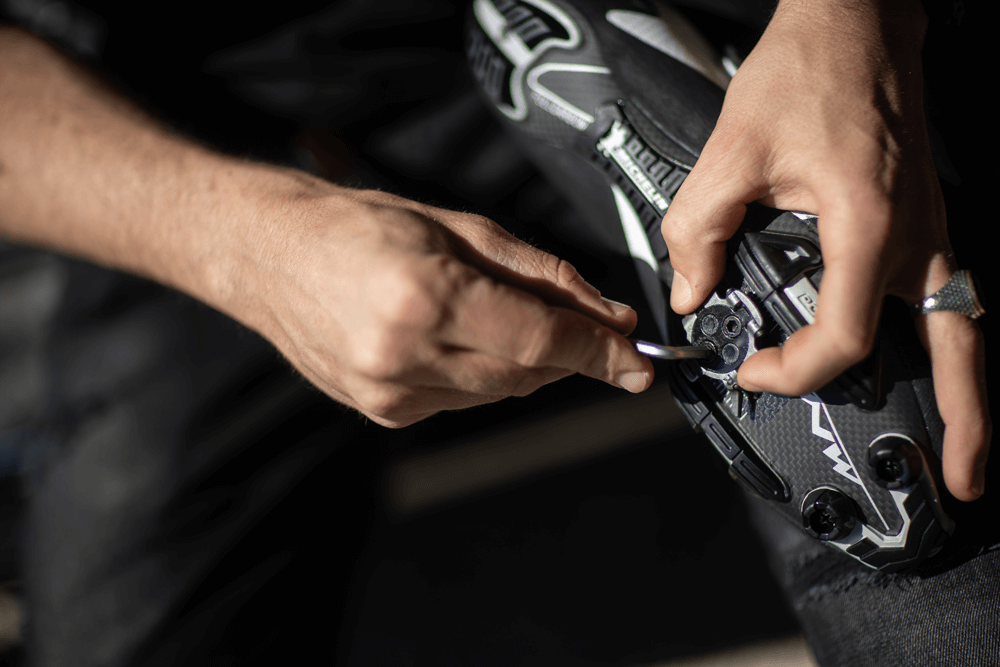As a beginner, whether on a road bike or MTB, you initially ride with 'regular' flat pedals, without a clip-in system. Once you've gotten used to the unique frame setup of a road bike and mountain bike in general, you'll quickly get hooked and want to boost your personal training achievements. An easy way to improve performance is by using clip-in systems. We will clarify here the advantages of clip pedals, the different systems available, and what beginners should pay attention to when using clip-in systems.
First, the terminology: With our little 1x1 of technical terms, you can now confidently participate in bike shop discussions.

Explained briefly: the key terms about clip-in systems
-
Clip Pedal, also known as a 'clip-in pedal,' allows a solid connection between the shoe and the pedal through binding elements. The binding system is similar to ski boots, but you only clip in the front part of the foot. The binding element is the shoe plate.
-
Shoe plates, also known as 'cleats' in English, are the connecting elements between the shoe and the pedal. A unit cannot be formed without them. Cleats are made of metal or plastic, depending on the system, and are a wear part.
-
Float angle is the lateral freedom of movement when the shoe is clipped in, meaning how far the cleat's rotation angle in the pedal can be without unclipping.
-
Release hardness describes how far or with what 'effort' the foot must be rotated outward to release the binding. Simply put, lower release tension means the binding will release with less movement.
-
Cleat covers are designed to protect the shoe plates, for example during running sections or when storing. They are also known as 'pedal plate covers' and are optional.
What advantages do clip-in systems offer?
Clip-in systems offer many advantages that platform pedals cannot provide. We will show you the most important benefits here, which even cycling beginners can quickly benefit from.

-
Optimized Power Transfer
With a clip-in system, the shoe and pedal become a solid unit. By limiting the range of motion, pedal force can be optimally transferred to the pedal, crank, chain, and ultimately the wheels with the same effort, resulting in increased performance. Cycling shoes also have a stiffer sole, further enhancing power transfer. Often, clip pedals are also lighter than platform pedals, reducing your bike's overall weight.
-
Performance Improvement
Once you master clipping in, you'll notice how your performance improves, even without increased training. This technique allows you to make your training more efficient. It also makes it easier to achieve a smooth pedal stroke, consisting of both pulling and pushing motions with your feet. The advantage here is that both movement directions, up and down, are efficiently utilized.
-
Ergonomic Position
When pedals and shoes are properly set up, posture issues can be prevented. Knee joints and the muscular system can also be relieved. The entire leg position becomes more efficient. Trained cyclists also notice a well-defined leg musculature – an attractive side effect.
-
Stability
Another safety aspect is preventing slipping in wet conditions. Even when standing and climbing uphill, the risk of slipping should not be underestimated. Regular sports shoes with relatively smooth soles typically do not provide enough grip. Standard pedals often have a flat surface or are called "bear claws." Nevertheless, without a secure connection, they cannot provide the stability offered by a clip-in system. Flat pedals and flat pedal shoes are commonly used for trekking or dirt biking. Given the longer walking sections in these disciplines, there is a compromise between walking and pedaling comfort.
-
Performance Enhancement on a Budget
Clip pedals and matching cycling shoes do not need to be expensive. You can find a solid pair of road cycling shoes for just under 100 euros, and the same goes for MTB shoes. A good pair of entry-level pedals can be found starting at 50 euros. The cleats for the shoes are included with the pedal purchase.
What clip-in systems are available, and what are the differences?
In general, a clear distinction can be made between off-road and on-road systems. This is due to the different requirements posed by road cycling shoes and MTB shoes. Here, we'll explain the differences using the most common systems from Shimano, SPD, and SPD-SL. The advantage of both systems is that they dominate their respective domains, and in terms of price-performance, they are hard to beat. However, other manufacturers like Look, Speedplay, Crankbrothers, Time, Voxom, etc., also offer different systems.
Shimano SPD-SL
 Shimano's SPD-SL clip system is designed for speed. SPD-SL pedals generally have a relatively large contact area in relation to the pedal's total size. The larger contact area allows for more efficient power transfer and better stability.
Shimano's SPD-SL clip system is designed for speed. SPD-SL pedals generally have a relatively large contact area in relation to the pedal's total size. The larger contact area allows for more efficient power transfer and better stability.
Therefore, the shoe plates are also slightly larger. While this makes walking more challenging, it improves power transfer and the connection to the pedal and frame. Because the pedal plates are exposed, they wear out more quickly due to walking or frequent and intensive use. Therefore, they are made of plastic. Shimano's pedal plates have two colored attachments at the end, toward the heel. These indicate the degree of wear and when the pedal plates should be replaced. They also feature a slight elevation at the front end of the pedal plate, which clips into the binding. When these are too worn, clipping in and out becomes difficult or impossible.
The SPD-SL cleats are attached to the shoes with three screws. The pedal plates can be individually positioned on the road bike shoes. To ensure the correct fit, you can check by repeatedly clipping in and out. However, it's advisable to tighten the screws only after finding the correct position.
Shimano offers three different types of pedal plates, allowing control of the cleats' lateral movement in the pedals. The selection of these plates depends on various factors:
-
Performance level / personal experience with clip-in systems
-
Personal riding style
-
Joint flexibility
-
Single-Release or Multi-Release unclipping
We recommend the yellow pedal plates (7517) for beginners, as they offer the most flexibility with up to a 6° rotation angle. This makes it easier to find the ideal foot-to-pedal position.
The pedal system itself can be individually adjusted depending on the model. Entry-level SPD-SL pedals have a low release tension, which is particularly useful for beginners to quickly release from the pedal, preventing falls.
Shimano SPD
The SPD clip system is designed for off-road use. As off-road trails often involve walking sections, embedding the cleats into the sole to protect them makes sense. The pedal plates are made of metal, making them more resistant to dirt and wear.
The cleats are attached with only two screws. The contact area is different from the SPD-SL system, as off-road cycling prioritizes efficient power transfer. Even in uphill sections, the pedaling motion, including pulling up on the pedals, is especially relevant.
It's important to distinguish between different off-road areas. The more aggressive the sport, the smaller the pedal cage, or the total pedal contact area. However, that doesn't mean the contact area is as small as the pedals. The actual contact area is determined individually by the depth of the pedal plates on the shoe. The flattened area around the cleat must rest on the pedal because that's where power transfer occurs. This notch is designed differently by manufacturers. In the trail and enduro disciplines, the pedal cage is intended more for protecting the clip system than for contact.
The lateral movement freedom of the foot, known as the float angle, can also be individually adjusted with SPD pedals. As a beginner, you may need to experiment more to find the right setting. Due to uneven terrain, greater foot mobility is required in MTB and Trail areas, which is why the float angle is set wider. However, a sharper angle provides a greater sense of security at the beginning. When trails become more challenging, the wider angle is beneficial because it allows active steering with the feet. However, this can lead to unintentional unclipping.
Shimano also offers various pedal plates for SPD, differentiated into Single-Release and Multi-Release options. Single-Release cleats allow easy disengagement, where the heel is turned to the side to release the binding. The Multi-Release shoe plate allows unclipping through outward heel rotation, tilting, or downward heel pressure. Hardness is also a factor here and can be adjusted on all Shimano SPD pedals using a screw.
Finding the right shoes for the right pedals
In general, different clip systems are usually incompatible with each other. However, it's possible to expand compatibility with adapters.
When purchasing the right cycling shoes, it's crucial to pay attention to compatibility. This information is usually included in the product descriptions.
Whether the shoe is compatible with SPD or SPD-SL can easily be determined by looking at the sole. As mentioned earlier, the attachment mechanisms differ, including the hole patterns. Therefore, it's common to choose a pedal system first and then buy shoes that match. However, there are manufacturers like Bontrager that offer dual compatibility for both mountain biking and road cycling pedal systems due to multiple hole patterns. We'll explain why this "double" compatibility can be interesting for beginners below.
It's important to note that the crucial element in pedal systems is having the right shoe. Just like regular shoes, cycling shoes must fit your feet. So, when transitioning to clip-in pedals, you will automatically encounter a new type of shoe.
Cycling shoes must snugly fit your feet to provide stability and facilitate optimal power transfer. However, they shouldn't be too tight since your feet tend to swell slightly while cycling, especially in the summer. This aspect is similar for different types of cycling shoes. The perfect fit of the cycling shoe is an absolute necessity because the pressure points on your feet during cycling always remain consistent. Due to the constant repetitive movement and increased load, minor friction points can quickly turn into painful feet.

3 Tips for Beginners
Now, let's summarize our advice and experiences for beginners to facilitate their transition to clip-in pedals, address their use, and alleviate concerns.
-
The Fear of Releasing Too Late
The biggest hurdle with clip-in systems is the fear of falling because you can't release from the pedals quickly – especially in city traffic, on the road, or in front of other cyclists. Not only does everyone witness it, but the ensuing bruises are also far from ideal. BUT: Clip systems are derived from ski bindings, and the binding can always be released. You don't need to fear twisted ankles or the like. Even if the likelihood of falling is high initially, it will only be the case at the beginning.
Later, when you become a "clip pro," you'll enjoy all the advantages that clip pedals offer.
-
Practice, Practice, Practice!
You'll only become a "clip pro" through practice. Ideally, position your bike so you can hold onto a wall or something similar. Then, start with getting on the bike, clipping in, unclipping, clipping in, unclipping... This will give you a sense of how to position your feet, the amount of effort required, and whether your pedal plates are correctly adjusted. It also helps develop muscle memory. Once you feel confident, plan only short rides, preferably not through urban traffic. And even if you do fall, don't worry. Let's be honest, everyone who switched to a clip system has fallen at some point. So, it all comes down to practice, practice, practice!
-
The Combo Pedal as an Intermediate Solution
If you're not entirely sure whether pure clip-in pedals are right for you, you can opt for so-called combo pedals. These are usable from both sides, with one side featuring a clip mechanism and the other side being a flat pedal. Combo pedals are only available in the SPD/Flat combination. The design of SPD-SL pedals doesn't allow such a construction since the pedal plate is recessed when clicked into the pedal, creating a convex shape on the underside of the SPD-SL pedal. This is a simple and cost-effective solution for MTB riders. If you want to use combo pedals with a road bike, you'll either need to switch to MTB shoes first or find road cycling shoes with holes for both pedal systems.
Our Conclusion
Transitioning to clip pedals is definitely worthwhile, even if you end up with a few bruises in the beginning. Increased safety and improved performance outweigh the initial challenges. Once you get the hang of riding with clip pedals, you won't want to go back. Being bold pays off!
P.S.: If you have any more questions, please leave us a comment or send us your inquiries conveniently via email. We're happy to assist you!



